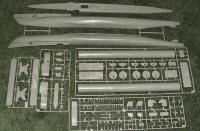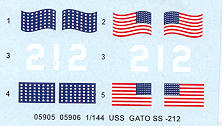
| KIT: | Trumpeter's 1/144 USS Gato (1941 fit) |
| KIT #: | 05905 |
| PRICE: | $42.95 |
| DECALS: | One option |
| REVIEWER: | Scott Van Aken |
| NOTES: | Full hull with stand |

| HISTORY |
USS Gato (SS-212) was the lead ship of her class of submarine in the United States Navy. She was the first Navy ship named for the gato, a species of small catshark found in waters along the west coast of Mexico.
Her keel was laid down 5 October 1940, by the Electric Boat Company of Groton, Connecticut. She was launched 21 August 1941 sponsored by Mrs. Royal E. Ingersoll, and commissioned 31 December 1941 with Lieutenant Commander William G. Myers in command.
After shakedown training at New London, Connecticut, Gato departed 16 February 1942, for Pearl Harbor via the Panama Canal and San Francisco. On her first war patrol from Pearl Harbor (20 April 10 June 1942), she unsuccessfully attacked a converted aircraft carrier 3 May before being driven away by the fierce depth charging of four destroyers off the Marshall Islands. On 24 May she was ordered to patrol the western approaches to Midway, taking station 280 miles westward during the Battle of Midway.
On her second war patrol (2 July 29 August 1942), she patrolled east of the Kurile Islands toward the Aleutian chain. She obtained four torpedo hits with unconfirmed damage to a ship 15 August 1942, and terminated her patrol at Dutch Harbor, Unalaska. Her third patrol (4 September 23 December 1942) included operations off Kiska; then she steamed via Midway and Pearl Harbor to Truk atoll, where her attack 6 December on a convoy was broken off by aerial bombs and a severe depth charge attack by three destroyers. This patrol terminated at Brisbane, Australia, 23 December 1942.
During her fourth war patrol (13 January 1943 26 February 1943), Gato torpedoed and sank transport Kenkon Maru 21 January; cargo ship Nichiun Maru on 29 January; and cargo ship Suruya Maru on 15 Februaryall off New Georgia, Solomon Islands. On her fifth war patrol (19 March 6 June 1943), she landed an Australian Intelligence party at Tope, Bougainville, 29 March 1943, and evacuated 27 children, nine mothers, and three nuns, transferring them 31 March to SC-531 off Ramos, Florida Island. During a submerged radar attack approach 4 April 1943, between Tanga and Lihir Islands, she was shaken so violently by three exploding depth charges that she returned to Brisbane for temporary repairs 11 April to 20 April. Gato landed more Australian commandos at Toep Harbor 29 May, transported more evacuees to Ramos Island, and then reconnoitered off Tarawa in the Gilbert Islands before putting in at Pearl Harbor 6 June 1943.
Gato was routed onward to the Mare Island Naval Shipyard for overhaul; returned to Pearl Harbor 22 August 1943; and conducted her sixth war patrol (6 September 28 October) via Truk and Bougainville in the Solomons to Brisbane. En route on 19 October she attacked a convoy, scoring hits for unknown damage to two large cargo ships. Her seventh war patrol (18 November 1943 10 January 1944) took her north of the Bismarck Archipelago. On 30 November she made a coordinated attack with Ray, sinking the cargo shipColumbia Maru. She rescued a Japanese soldier from a life-raft on 16 December; then attacked a convoy in the Saipan-Massau traffic lanes four days later to sink cargo ship Tsuneshima Maru and scored damaging hits on another freighter. After two hours of dodging depth charges, she finally evaded her attackers; surfaced and headed for Tingmon, the most likely course of the damaged cargo ship. Gato discovered a live depth charge on her deck at the same time that two enemy escorts headed in her direction were sighted. She outran them while disposing of the unexploded depth charge by setting it adrift, on a rubber raft. Although she did not overtake the cargo ship, she did sight a convoy. On 2 December her chase was foiled by a float plane finally driven off by her gunners. She concluded the patrol at Milne Bay, New Guinea, 10 January 1944.
Gato departed Milne Bay 2 February 1944, to conduct her eighth war patrol in the Bismarck-New Guinea-Truk area. She sank a trawler off Truk 15 February, transport Daigen Maru No.3 the 26th, and cargo ship Okinoyama Maru No.3 12 March. Two other trawlers were destroyed by her gunfire before she returned to Pear Harbor 1 April 1944.
On her ninth war patrol (30 May 1944 21 June 1944) Gato took Vice Admiral Charles A. Lockwood to Midway; completed photographic reconnaissance of Woleai Island, served on lifeguard station for air strikes on Truk 11 June to 18 June, and terminated her patrol at Majuro atoll. On 15 July 1944, she was underway on her 10th war patrol taking lifeguard station for the carrier-based air strike on Chichi Jima, during which she rescued two aviators. She returned to Pearl Harbor on 2 September 1944, proceeded to Mare Island for overhaul and then returned to Pearl Harbor.
On her 11th war patrol (28 January 13 March 1945,) Gato patrolled the Yellow Sea as a unit of a coordinated attack group which included Jallao (SS-368) and Sunfish (SS-281). She sank a coast defense ship on 14 February and cargo ship Tairiku Maru on 21 February, then returned to Guam. She departed on her 12th war patrol 12 April 1945, taking lifeguard station in support of the invasion of Okinawa. On the night of 22 April and 23 April she had a brief contest with two Japanese submarines and narrowly missed destruction as well-aimed torpedoes came close. Between 27 April and 30 April she rescued 10 Army aviators from shallow water near the beaches of Toi Misaki, Kyushu. She returned to Pearl Harbor 3 June 1945.
On her 13th war patrol Gato departed 8 July for lifeguard station for air strikes on Wake Island and then off the eastern coast of Honshu. She received word of "Cease Fire" 15 August while making an attack approach on a sea truck; steamed into Tokyo Bay the 31st; remained for the signing of surrender documents on board Missouri 2 September; and then departed the following day via Pearl Harbor and the Panama Canal to the New York Naval Shipyard, where she decommissioned 16 March 1946. She served for a number of years as a naval reserve training ship at New York and later at Baltimore, Maryland, until her name was struck from the Naval Vessel Register on 1 March 1960. She was sold for scrapping 25 July 1960, to the Northern Metals Company of Philadelphia, Pennsylvania.
Gato received the Presidential Unit Citation in recognition of daring exploits during war patrols four through eight and 13 battle stars for service in World War II.
Several Gato class submarines are still extant as museums and SSN-615 was named Gato when launched.
| THE KIT |
 Whether by happenstance or trying to cash in on the upcoming Revell 1/72 Gato class sub, this one by Trumpeter is very nicely done. It is a very large model, even in 1/144, but not one that has a lot of parts. There are two main hull halves and an upper deck which are molded in one piece, so no worries about trying to get four part hull together. The pressure hull takes up more of the parts and has a lot of braces in it. This is to add the required stiffness to the overall boat model and to give one something to see through all the air release holes in the outer hull. A similar, but much smaller construct is provided for the conning tower.
Whether by happenstance or trying to cash in on the upcoming Revell 1/72 Gato class sub, this one by Trumpeter is very nicely done. It is a very large model, even in 1/144, but not one that has a lot of parts. There are two main hull halves and an upper deck which are molded in one piece, so no worries about trying to get four part hull together. The pressure hull takes up more of the parts and has a lot of braces in it. This is to add the required stiffness to the overall boat model and to give one something to see through all the air release holes in the outer hull. A similar, but much smaller construct is provided for the conning tower.
This is the Gato in her earlier configuration before additional anti aircraft guns were added and the enclosed bridge was removed for the forward gun. I would imagine that in the later war boxing, the sprue with the bridge structure will be replaced with the later version. Most of the parts are for the bridge structure and for the myriad of stanchions and tie-downs that festoon the upper deck of a sub. As such, you can pretty well build the kit and then paint it. It also appears that the forward dive planes can be built in the up position if you so wish.
 Instructions are typical for Trumpeter with a good parts layout and excellent construction steps. The painting guide is as simple as one can get with the upper deck being in what is called Medium Gunship Grey and the rest of the boat in Black. I think this is supposed to be Measure 10 where everything above the waterline is in Ocean Grey and that under it is Black. The only other option would be Measure 9 where the entire boat is in Black. Those were the only two used prior to 1943, so take your choice! A small decal sheet provides bridge numbers and flags. From what I've read, those bridge numbers would have gone away during hostilities so if you use them you'll be doing a pre-war boat.
Instructions are typical for Trumpeter with a good parts layout and excellent construction steps. The painting guide is as simple as one can get with the upper deck being in what is called Medium Gunship Grey and the rest of the boat in Black. I think this is supposed to be Measure 10 where everything above the waterline is in Ocean Grey and that under it is Black. The only other option would be Measure 9 where the entire boat is in Black. Those were the only two used prior to 1943, so take your choice! A small decal sheet provides bridge numbers and flags. From what I've read, those bridge numbers would have gone away during hostilities so if you use them you'll be doing a pre-war boat.
| CONCLUSIONS |
Submarine fans will love this one. It is big and looks to be quite impressive when done. Those who normally don't do boats will like it as well for the simplicity of construction and because it will just look cool in with your other 'stuff'. I'm sure it will sell well as many of us would like the more detailed Revell kit, but would rather find room for a 26 inch long model than a 52 inch version!
| REFERENCES |
Osprey's US Submarines 1941-45, 2006 My thanks to Steven's International, Trumpeter's importer, for the preview kit. If you would like your product reviewed fairly and quickly by asite that has nearly 325,000 visitors a month, please contactme or see other details in the